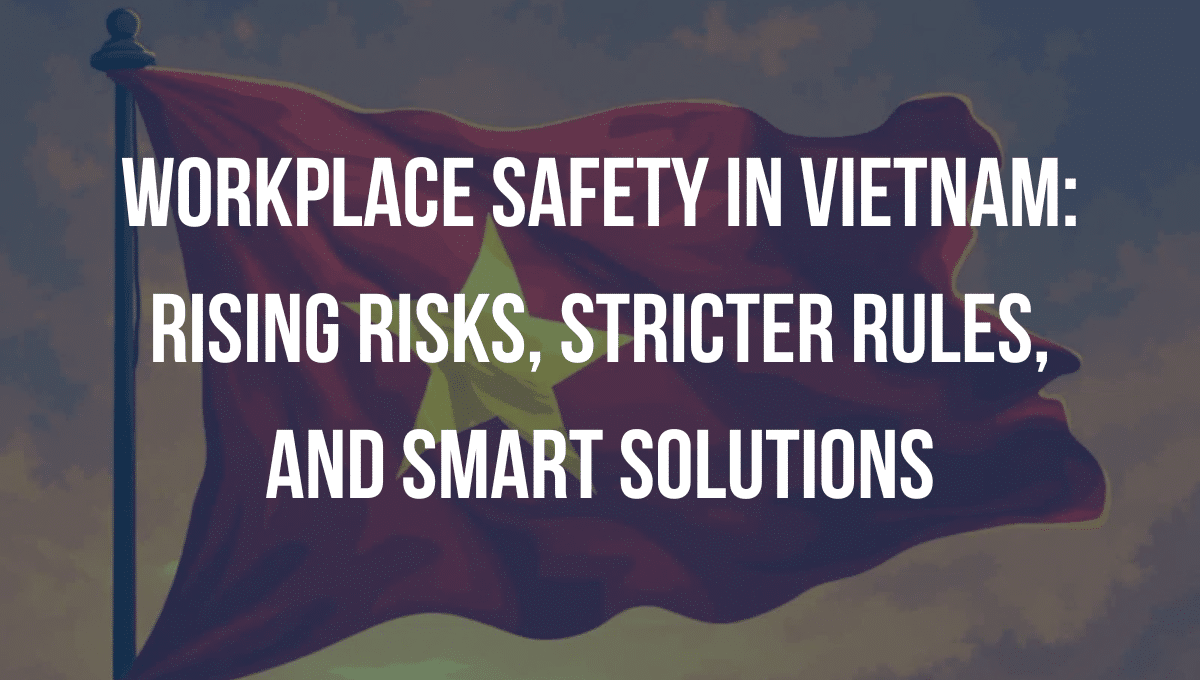Vietnam’s rapid industrialization has brought both economic growth and workplace safety challenges. In 2024, workplace accidents cost the economy 43 trillion VND ($1.68 billion USD), a sharp rise from 2023, driven by negligence in high-risk sectors like mining and construction. Meanwhile, new regulations and cutting-edge technologies aim to protect workers and reduce losses. Here’s a breakdown of Vietnam’s safety landscape in 2025.
1. Workplace Accidents: Trends and Costs

Escalating Incidents
- 8,286 accidents occurred in 2024, injuring 8,472 workers—a 12% annual increase.
- Mining, construction, and manufacturing accounted for 62% of fatal accidents, often due to employer negligence.
- Case Highlight: In April 2025, seven workers died at Yen Bai Cement during equipment maintenance, prompting nationwide safety audits.
Economic Toll
- Productivity losses: 154,759 workdays lost in 2024, with construction workers needing 21 days average recovery time.
- Compensation costs: Rose 33%, averaging 1.2 billion VND ($47,000 USD) per fatality, straining small businesses.
Vulnerable Workers
- Migrant laborers faced 68% of fatalities, often lacking contracts or safety training.
- Gender disparity: Women made up 22% of victims but 89% of injuries in textiles due to poor machine guarding.
2. Regulatory Reforms: Stricter Enforcement

Food Safety (Decree 15 Amendments)
- Simplified licensing: Removed four procedures for food additives and GMOs.
- Tighter controls: Mandatory formula disclosures for modified foods, extending approval times by 14–21 days.
- Local oversight: Provincial authorities now conduct unannounced inspections.
Impact: Critics argue compliance costs could hit $230 million/year for SMEs, but regulators aim to curb 12,000 annual foodborne illnesses.
Labour Code Updates
- Health checks: Biannual exams for high-risk workers (e.g., chemical handlers).
- PPE mandates: Employers must provide gear meeting government standards.
- Air quality: Factories with particulate matter over 50 µg/m³ need real-time monitors.
- Penalties: Fines doubled to 450 million VND ($17,600 USD); 1,243 firms fined in early 2025.
3. Innovations Transforming Safety
Smart PPE
| Traditional PPE | Smart PPE | Impact |
|---|---|---|
| Basic helmets | Thermal imaging, UV sensors | Reduced heatstroke by 27% in trials |
| Standard gloves | Gas detectors + real-time dashboards | Faster hazard response |
| Regular vests | Biometric monitors for heart rate | Cut overexertion injuries by 19% |
Sustainable Materials
- Recycled PPE: Duy Tan Plastics’ safety goggles use 30% ocean plastics.
- Clean production: Solar-powered factories in Binh Duong cut PPE carbon emissions by 41% since 2023.
Industrial Safety Tech
- Predictive maintenance: Schneider Electric’s Hanoi plant reduced downtime by 33% using AI.
- Global growth: Vietnam’s energy sector drives a 6.5% annual rise in industrial safety tech demand.
4. The Road Ahead for Workplace Safety in Vietnam: Challenges & Solutions

Vietnam aims to slash workplace fatalities by 30% by 2030, but gaps remain:
- Informal sector oversight: Many accidents go unreported.
- SME support: High-tech PPE costs hinder adoption.
Recommendations
- Subsidies: Tax breaks for SMEs to adopt smart PPE.
- Blockchain reporting: Transparent accident tracking.
- Safety training: Integrate protocols into vocational programs.
Conclusion
Vietnam’s push for safer workplaces hinges on balancing stricter laws with tech-driven solutions. While risks persist in mining and manufacturing, innovations like AI-powered gear and recycled PPE offer hope. By empowering local regulators and investing in worker education, Vietnam can turn its safety challenges into opportunities for growth.
Stay safe, stay informed—innovation is the future of protection. 🛡️🇻🇳
Any Questions? Contact Us:
📩 Email: [email protected]
🌐 Website: www.safetyware.com
📞 Contact us: WhatsApp

